
The Dos and Don’t-You-Dares of Copywriting
Details
The right words hook customers and make you money. But bad copywriting skills costs US companies over $400 billion each year—and yes, that stat is real. They’re even spending $3.1 billion each year on remedial writing training.* (It makes our hearts hurt.)
Copywriting isn’t a soft skill, it’s a core business tool. So put on your writing hat, grab some caffeine, and let’s get to work. Join our exclusive webinar with Lately.ai CEO Kate Bradley Chernis to learn how to turn flavorless statements into spicy calls-to-action.
Whether you’re a copywriting novice or a Google Doc veteran, you’ll leave this webinar with bang-your-hand-on-your-forehead ideas and a new understanding of how every word you write can convert.
What you’ll learn
- The dos and don’ts of effective copywriting
- Strategies for effectively pairing copy and visuals
- Tools that can elevate your copywriting across all your social channels
Please complete the form to register
* indicates required fields
Transcript
Words have power. You know it, we know it.
The right words hook customers and make you money. But bad copywriting skills costs US companies over $400 billion each year—and yes, that stat is real. They’re even spending $3.1 billion each year on remedial writing training.* (It makes our hearts hurt.)
Copywriting isn’t a soft skill, it’s a core business tool. So put on your writing hat, grab some caffeine, and let’s get to work. Join our exclusive webinar with Lately.ai CEO Kate Bradley Chernis to learn how to turn flavorless statements into spicy calls-to-action.
Whether you’re a copywriting novice or a Google Doc veteran, you’ll leave this webinar with bang-your-hand-on-your-forehead ideas and a new understanding of how every word you write can convert.
Use these social media copywriting tips to take once-bland posts and turn them viral or spruce up your sales copywriting to sell more with less effort.
What You’ll Learn:
The dos and don’ts of effective copywriting for beginners
Strategies for effectively pairing copy and visuals
Tools that can elevate your copywriting across all your social channels
Companies waste $400 billion on bad writing each year
People think of writing as this soft skill that everybody can do but in reality it’s a lot harder than you think. What's crazy is that writing goes across the company. It doesn't matter if you're in marketing or sales, or if you're in engineering or accounting. Everyone has to write to communicate with each other. And because of that, companies are spending $3.1 billion on remedial copywriting training.
The rules that we're going to cover are the same rules that Latey.Ai lives by. AI is nice, but you still need to review what is being produced and without a base knowledge, how can you effectively know what will work. We are going to pull back the curtains and go behind the scenes at how Lately.Ai’s CEO Kate Bradley used copywriting rules that grew their revenue240% in 12 months.
Rule number one | Write like a boss
Confidence is everything. It's not what you write, it's how you write it.
Don't undercut your own authority. Everything about sales and marketing is about getting somebody to do what you want them to do, This is about communications in general. It doesn't matter if you want your husband to take out the trash or your son or daughter to do their homework or your marketing manager to turn in the email copy for the newsletter. All communications come down to exactly that. Get people to do what you want them to do. They have to trust you to do that. And if you don't have the authority in place, then they're not going to.
Avoid weak words like;
Need: a needy team is needy.
Think: You don't think, you know
I just wanted to say something: See how weak that is?
Probably, maybe, possibly.
It's not that you can't use these words, that they don't have a place. They have a great place in customer service, because when you put yourself in the apologetic role, which you have to do a lot in customer service, those words come in handy.
Pro Tip: Use visuals, emojis and special characters in your copy to break up the monotony of text.
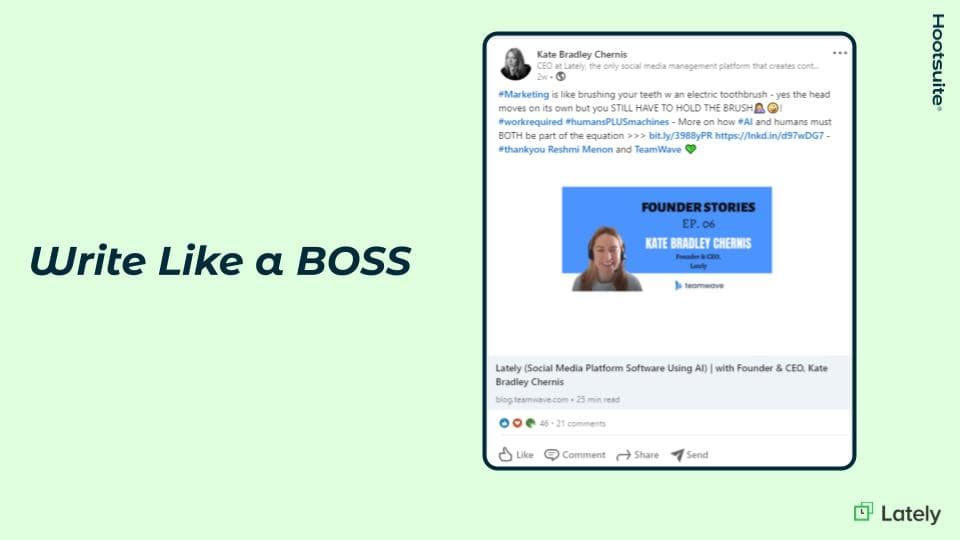
Check out my blog, check out this podcast, check out my meal. Whatever it is. This phrase should be removed from your vocabulary for multiple reasons:
We have an entire dictionary of wonderful words that you can access that thesaurus is your best friend, obviously.
You’ll look spammy. Choose words that describe what action you want the reader to do. Do you want them to click on a specific link or check something out?
Your authority may be questioned. Avoid the feeling of the unknown when it comes to your content. What's gonna happen if I click this link? I'm questioning it, I'm questioning your authority.
Trust goes out the window. Without an understanding of whether something is worth a reader’s time, they may consider it too click-baitey.
You sound lazy. Take the time to write copy that gives your audience a clue on what the content is about.
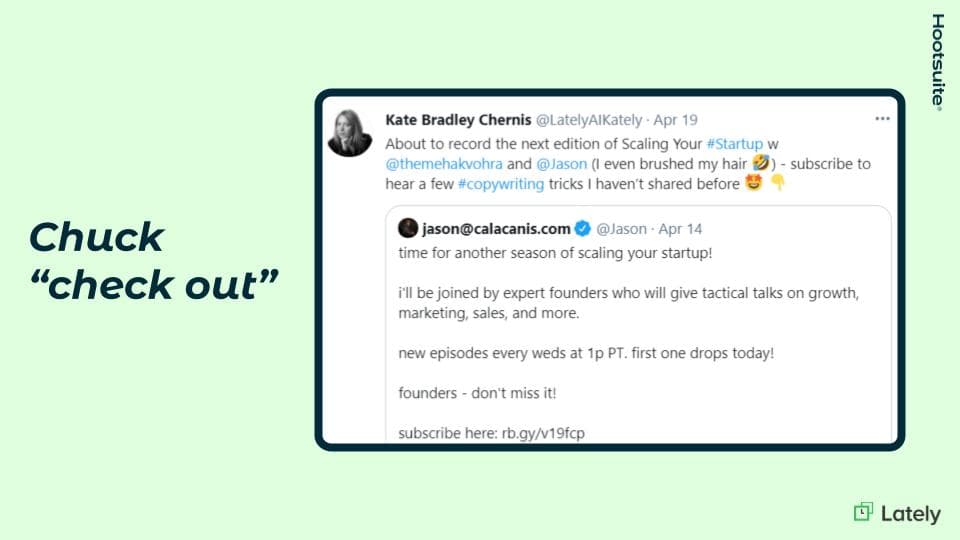
In this example, Kate uses an action verb to describe what she wants the audience to do. “Subscribe to hear a few copywriting tricks”. She purposely said that “I haven't shared before” to elicit an element of mystery or intrigue.
By mentioning “I even brushed my hair” not only brings in humor, but also shows the reader that she’s not only human and relatable, but also she’s funny and learning from her would be fun. Adding a little personality to your posts gives people enough of yourself that makes people want to just learn more.
When Kate says, “Don’t bury the lead” she’s referring to the main point of the story, or Aha moment. Writers are taught in school to hold on to the lead tightly until the story really begins to unfold. Think about when you used to write essays for class, you begin with an introductory paragraph, then outline your ideas and claims. It's not until the end when you’ve finally reached the point of the paper where everything comes together.
In today’s digital world, people are distracted. Content moves quickly, scrolling doesn’t stop unless you’ve given them something worth holding on. As a result, you have to get to the point immediately. There’s no easing readers into what you’re trying to say.
In order to grab attention and stop the scrolling, you have to “86” (or cut) the preamble and lean on the verb or action you want the reader to take.
Pro Tip: Get it on paper with a brain dump then edit down. Start by taking out the first four or five words of the copy and start with a verb. Then turn the verb into an active verb, if it isn’t already. You'll end up with a stronger statement which lends authority and builds trust. The statement will also become a command by default and in turn, a CTA.
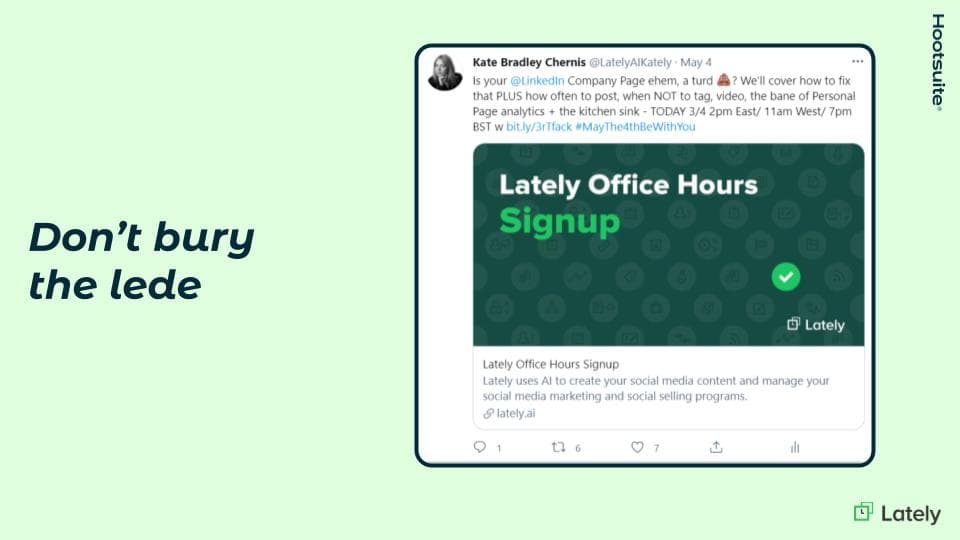
A lot's happening here. Don't bury the lead. I'm telling you exactly what's going to happen if you come to this workshop on LinkedIn right now. I'm starting it out with a question, which is a great way to start anything. And I'm doing it to try to get you to right away think, “is my LinkedIn company page a turd?”
Humor is obviously important and memorable, but do it in a way that gets straight to the point. This post is clear on what’s going to happen and what the topic will be about. .
Rule Number Four | Use Negative CTAs, Not Positive
This doesn’t mean you should be negative online. Think about the call-to-action and how they are phrased. By phrasing your CTAs in a negative way, you’re creating a sense of urgency or FOMO.
For example: “Remember…” is positive action vs. “ Don’t forget…” is negative. When you use a negative call to action, people respond almost 30% more.
This tactic taps into the inner child in all of use. (Think emotional marketing here) By using negative CTAs your essentially tricking the mind into thinking you’ve done something wrong, so you’ll try harder to action on whatever the CTA is telling you.

This post is full of negativity, but in the best way. Let’s break it down. It starts off building authority with the statement, “Words are the DNA of every sales pitch”, then immediately going into another more negative statement, “The wrong words are costing companies $400 billion in the US alone”. By using the word “wrong”, immediately forces the reader to question their own work. Followed by the negative call to action, “Don’t let that be you.” It’s barely even a CTA at all but it hits the reader on an emotional level and creates a pain point. So as the reader, you’re feeling a sense of FOMO and questioning whether or not your own work is costing your company money. Where the post pulls you in is following up the negative with a solution. “Join moi for a free course”. Of course, you want to join this course, otherwise you may end up being part of the group that costs companies billions!
Pro tip: Avoid “resting bitch face” in your writing by reading your posts out loud. While reading, emphasize what's there and try to feel how it comes out of your mouth, because reading in your head can sound much different. In social you don’t have the same copy tools, like bold or italics, as say an email, so using visuals really come in to aid the importance of what you’re saying.
Think about the questions that include; who, what, why, where, how, when. They immediately inspire an answer. When you write copy that includes “why” specifically, it must be followed by “because”. Why? Because, “why’ creates a blank that needs to be filled. A great tactic is to leave the “because” behind the click, which will trigger an understanding that the next step to get the answer includes trust because it resolves the “why”. Why also gives you an added bonus of another visual with the question mark. Again, presentation of the copy is almost as important as the copy itself. (No RBF here!)
You can also use “because” at the start of a sentence, despite whatever your English professors told you, when you do that, it creates pause.
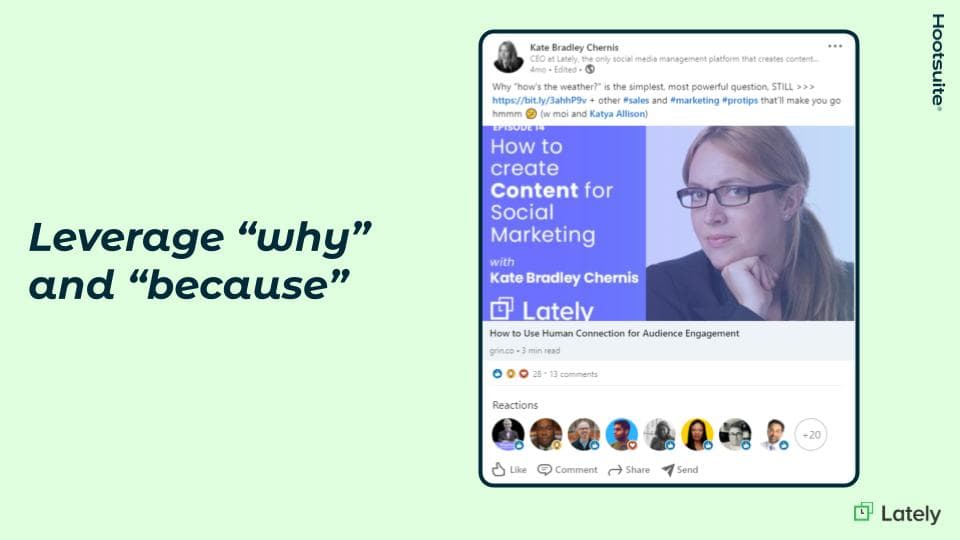
Even though the post isn’t outright asking a question, the reader still questions the answer. By starting the post with “why” you’re eliciting wonder and the understanding that the answer will be included in the link. Don’t disregard the use of weather here. Or other questions like “how/where are you?”, “Where do you live?”, etc. All these bring us together. It's an instant connector, which if we’ve emphasized earlier in the webinar. Don’t forget the use of copy visuals! (See the trend?)
Play to the ego. The psychology of writing is really important. It plays a big role here. Social media especially thrives on ego. In writing, there's a trick that you can use and you can use it not just in social, but anywhere. It's about really thinking about how other people perceive the word “I” in text. When you use “I”, it instantly puts all the focus on you. But the conversation isn't about you, it's about who you're selling to. Everybody knows this. When you're selling, you ask people to talk about themselves because everybody loves to talk about themselves. What happens is when you let the person you are selling to talk, you can sell to meet their needs.
When you're writing, try to take out the “I”. It can be challenging because you have to pay attention to the grammar. But there are a lot of times when you can either swap the “I” with “we” and sometimes “you”. “We” is inclusive and “you” forces empathy.
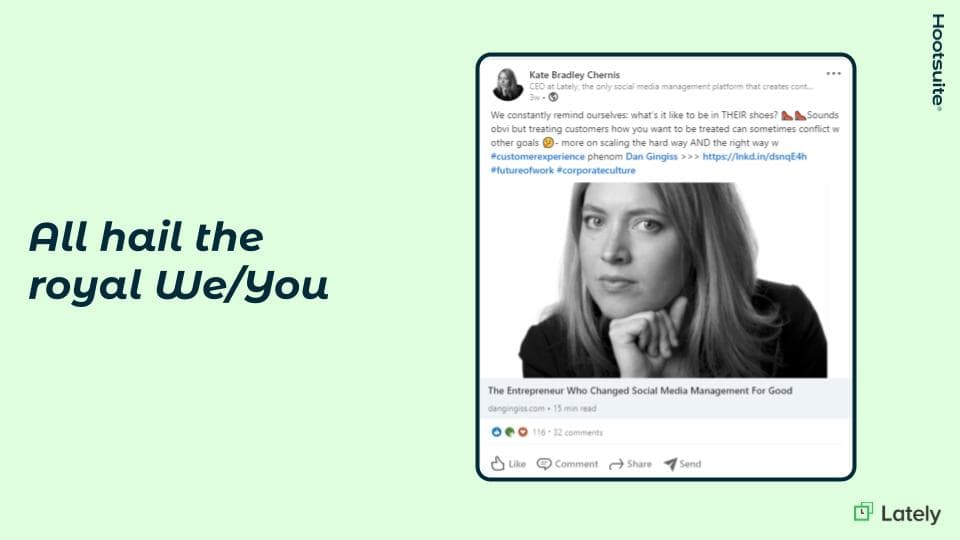
The first sentence is making an assumption. “We constantly remind ourselves” who's the “we”? Think about the audience when writing posts like this. For this example, the audience is most likely women focused, but it can be applicable to anybody. The “we” is vague enough that it could be anyone. What this statement does is put the reader in someone else’s shoes > insert empathy.
The copy visuals help cement the reader into thinking about the other people in the post, which triggers the idea of sympathy. This post also uses a more casual tone as the audience receives it better than when the tone is too stiff. The more casual the language, the more likely engagement will increase. Yes, you can do this if you are a banker or a very large company, there's always a way. That vernacular kind of casual speech lends you authority and trust because it shows that you're a real person.
The post brings in mystery by using “sometimes conflict with other goals”. This is how you tell a story while burning the lead. You’re not technically burning it, you're just alluding enough to it. So why would you treat customer? What's the different way? Like what, what is the goals? That conflict, right? Sometimes it's making money. That's actually what I'm talking about. Which, which Dan and I talked about in, in the thing in, in our podcast here. The other thing that I've, I'm doing is giving you a little bit of a call to action, more on scaling the hard way and the right way.
So there's more mystery. I'm trying to give you an understanding of what we're going to be talking about, but I'm not gonna give you the whole kitchen sink here. And then I'm qualifying who Dan is by saying it's customer experience. So this particular podcast touches on a lot of things, but that's the general subject. And I'm doing that. So when you click it as opposed to saying check out, you have a good idea of what you're gonna get here. It's not, not the full reveal, but a teaser.
Rule Number Seven | Read what you write out loud
A great way to determine if your copy will resonate with your audience is to read it out loud. If it feels awkward saying it, it feels awkward reading it. When it feels awkward to the reader, they don’t trust you.
Remember, you're trying to reach people. Your writing should feel human, natural and familiar.
Bonus: Reading out loud is a great way to catch mistakes.
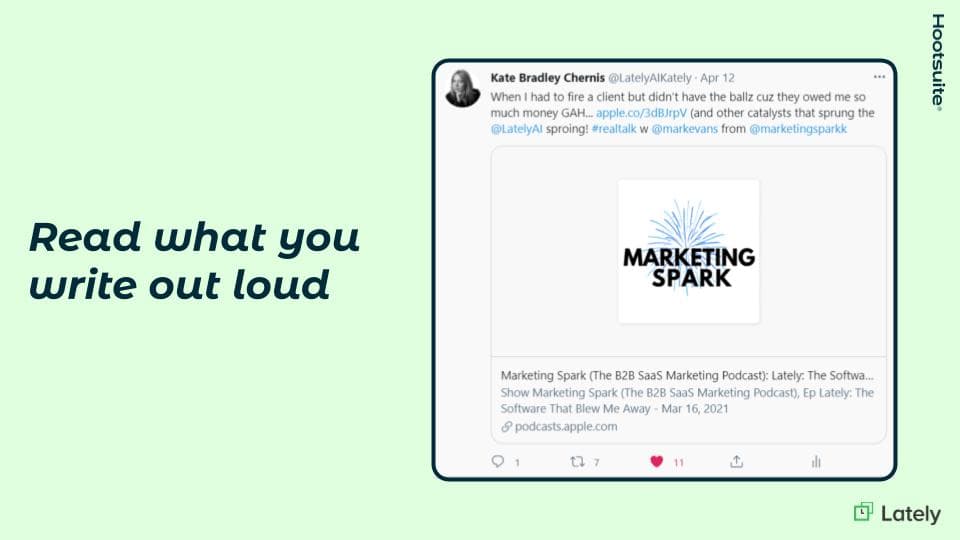
A lot is happening here. Kate gets away with this free flowing speech because it fits in with her persona, but not everyone can do it. Remember, this is a great time to read out loud so you can hear it how it sounds.
This is fun to say. It's fun to read, right? The post is looking for the lean in and the reaction. That's the first step in order to get the audience to do what you want.
Rule Number Eight | Write with your eyeballs
Make smart use of the keyboard/keypad.
Think: Spacing, numbers, exclamation points, question marks, percent signs, semicolons, colons, en/em dashes, parentheses, ellipses, emojis.
Like food, how you visually arrange words makes what you’re trying to communicate more digestible. (Plus, it builds trust.)
We touched on this before, but let's get back to it. Someone asked about all capitals, there's so many more things you can use. You've got this whole keyboard in front of you, right? Or your, or on your your touch pads, right? So really think about how things look. Let's go to the next slide. And I will show you and just remind you of all the things we've talked about before.
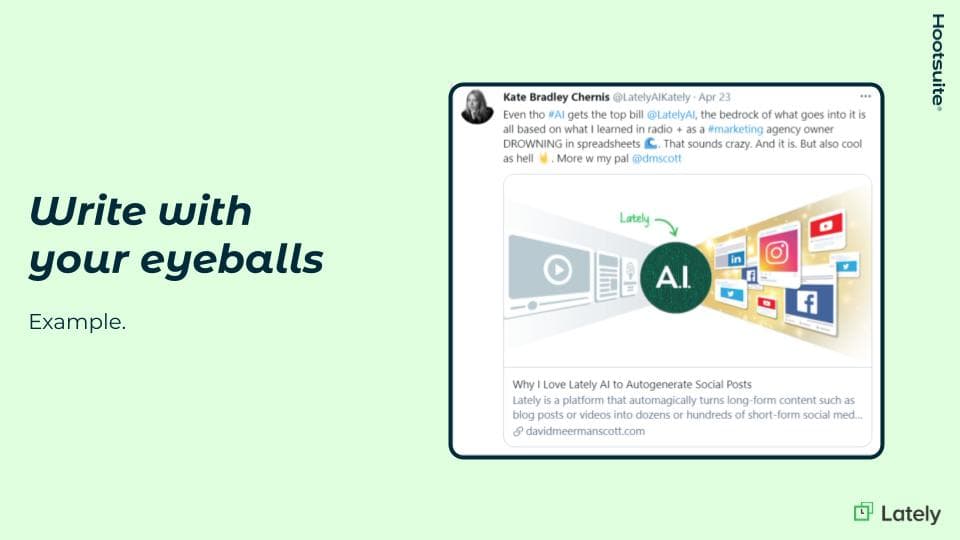
Pay attention to the rhythm of the post. It starts with a long sentence, then changes the staccato with a shorter one. The change of rhythm makes the post more entertaining and keeps the momentum going. The post also includes inline hashtag, @ mentions, and visual text which breaks it up nicely. Again, we can’t emphasize social posts like other forms of copywriting, so we use the visuals we have. By making the word “drowning” all caps, the reader is meant to feel that with Kate. Insert empathy >> see how we did that there again? Who else has been drowning in spreadsheets? By including the wave emoji, the post is attempting to lighten up the tone and provide a little sense of humor.
At the end of the day, when it comes to social media copywriting, break the rules. Be smart how you do it by testing everything, but break them!
Have compassion. This is the golden rule. And it may be the most important rule that we all forget. The person who you're trying to communicate with, whether it's your engineer or your head of sales, or your cousin or your mom or the guy at the coffee counter, or the woman at the library, they have their own lives and days to consider.
It's not only just thinking about this before you honk your horn at the next person driving by you like a jerk. It’s also thinking about how you get what you want from people. That's the most important thing. What's the true objective? And are you actually helping people get there with you?
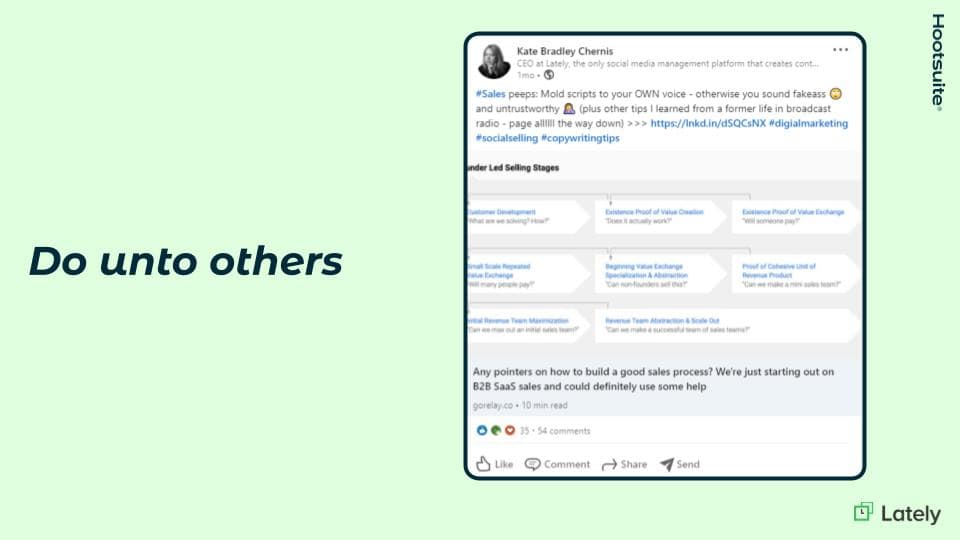
The post is calling out a specific group of people, ie. Sales peeps. Kate is writing this in her own style making it sound human and relatable, not a brand. Remember, people like interacting with people.
She’s using the word “mold” as the verb. Use words that relate to your tone of voice.
Bring your knowledge of social media down to two things; clicks and shares. You want people to do something, own that and then work backwards for what it is. If you know that clicks and shares are the only two outcomes that you're going to get on social media, let's think about how those work.
Clicks are very hard for small businesses because we don't have enough trust yet. People don't know us enough to get those clicks except with how-to content. Think about ways to phrase what you want people to do that is clickable. You raise the question of “why” and leave the “because” or answer behind the click.

Sharing is a little tougher. Shares are about ego. It's all about making people look smart. So in college someone would come to you with a new record and you'd be like, “Oh my God, this is an amazing band. Who are they?” And then you would share it with a friend and you got the credit of being the taste maker. Social media works the same way. If you share someone else's content, you look cool. You're the one who looks smart. If you write with that in mind, think about what's shareable here.
Rule Number Eleven | Dog-Food your own marketing
Dog food, everything you do. The metaphor comes from Purina. They couldn't sell their dog food. It wasn't doing very well. And then they decided to put a dog from someone in the company on TV, eat the dog food and show people that dogs actually like it. Drinking your own champagne is the same idea. Your employees are where it starts.
Communications is tapping into the networks that are often bigger than ours, especially when we're smaller businesses. Because you need help from other people. You rely on that help. It's the village, okay? Your employees are the first village. So first of all, make sure they love working there. Second of all, employ them to help you share the messages.
Speakers

Lately.ai

Hootsuite
Related resources
Engaging the Digital Generation: Social Media's Role in Student Retention and Success
With budgets stretched thin and increasing pressure to prove return on investment, educational institutions are constantly seeking new and innovative ways to optimize their budgets while providing students with exceptional learning experiences.
Create Posts That Drive REAL Results Fast
Social pros know: It can be a real struggle to keep up with the demands of creating fresh, engaging content every day.
3 Social Trends Nonprofits Should Know
Social marketing, customer service, and commerce are shifting with customer behaviors and larger economic forces. With that comes more opportunities for social marketers to get ahead. But where do nonprofit organizations fit into the mix?
Interested in learning more with Hootsuite?
Request a demo



